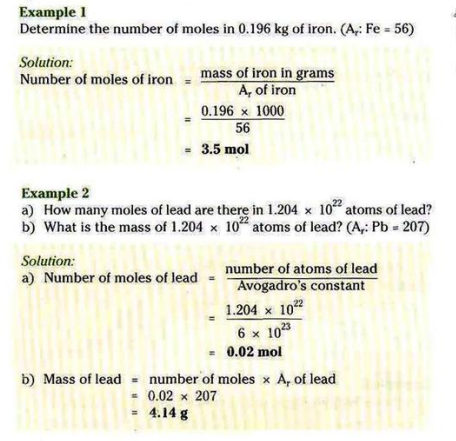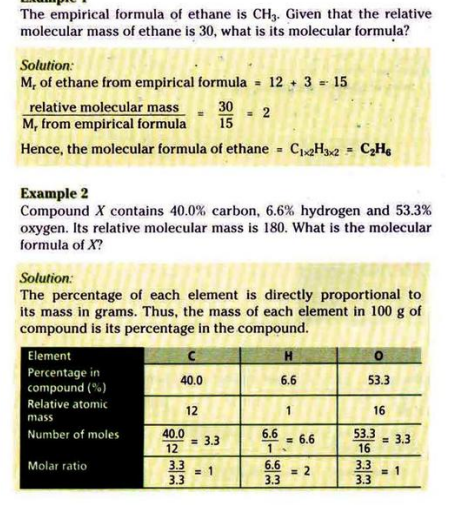
Chapter 9- The Mole
Mole: the unit of amount of substance in chemistry, its symbol is mol.
Stoichiometry: the relationship between the number of moles of reactant and the number of moles of products in the same chemical reaction.
Relative Atomic Mass: the mass of one atom of an element compared to 1/12th of the mass of one Carbon-12 atom.
Relative Molecular Mass: the mass of one molecule of an element/compound compared to 1/12th of the mass of one Carbon-12 atom.
Relative Formula Mass: the molecular mass for ionic compounds.
Avagadro’s number/constant: one mole of any substance contains 6x1023 particles.
Empirical Formula: the simplest ratio of atoms or elements present in a compound.
Molecular Formula: shows the number of atoms of each element in a compound.
Molar Mass: Mass of 1 mole of a substance.
Molar Volume: Volume occupied by 1 mole of gas. At r.t.p, one mole of any gas occupies 24 dm3.
Concentration: Amount of solute dissolved per unit volume of the solution.
Yield: the amount of product formed in a reaction.
Theoretical yield: the calculated amount of product that would be obtained if the reaction would be complete with no external factors acting upon it.
Actual yield: the amount of product formed in a reaction..
Percentage yield: the relationship between the actual and theoretical yield.
Percentage purity: the percentage of the mass of pure substance upon mass of the whole sample.
Limiting reactant: the reactant that determines the amount of product formed because of having fewer moles.
Excess reactant: the leftover reactant after the reaction has stopped.



Chapter 9- The Mole
Mole: the unit of amount of substance in chemistry, its symbol is mol.
Stoichiometry: the relationship between the number of moles of reactant and the number of moles of products in the same chemical reaction.
Relative Atomic Mass: the mass of one atom of an element compared to 1/12th of the mass of one Carbon-12 atom.
Relative Molecular Mass: the mass of one molecule of an element/compound compared to 1/12th of the mass of one Carbon-12 atom.
Relative Formula Mass: the molecular mass for ionic compounds.
Avagadro’s number/constant: one mole of any substance contains 6x1023 particles.
Empirical Formula: the simplest ratio of atoms or elements present in a compound.
Molecular Formula: shows the number of atoms of each element in a compound.
Molar Mass: Mass of 1 mole of a substance.
Molar Volume: Volume occupied by 1 mole of gas. At r.t.p, one mole of any gas occupies 24 dm3.
Concentration: Amount of solute dissolved per unit volume of the solution.
Yield: the amount of product formed in a reaction.
Theoretical yield: the calculated amount of product that would be obtained if the reaction would be complete with no external factors acting upon it.
Actual yield: the amount of product formed in a reaction..
Percentage yield: the relationship between the actual and theoretical yield.
Percentage purity: the percentage of the mass of pure substance upon mass of the whole sample.
Limiting reactant: the reactant that determines the amount of product formed because of having fewer moles.
Excess reactant: the leftover reactant after the reaction has stopped.



 Knowt
Knowt
